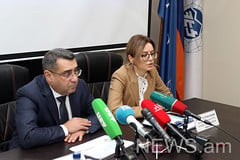In 2017, Armenia may afford some extra debt for long-term growth, Mr Hossein Samiei, Mission chief for Armenia at the International Monetary Fund, told Armenia News – NEWS.am at the IMF/World Bank Spring meetings in Washington DC.
The Extended Fund Facility program with the IMF, which disbursed SDR 82.21 million (or approximately $112 million), is ending in June. Armenia is considering requesting a new program in support of reform efforts. IMF is in the early stages of talks with the government on a new program, which, Mr Samiei said, the country can reasonably afford.
The country can also benefit from new borrowing from other international financial institutions and donors for capital spending, he said.
Earlier, the authorities tightened the fiscal rule of the planned budget for 2017, envisaging a large reduction in the budget deficit from 5.6% of GDP in 2016 down to 2.8%. In early 2016, economic activity had started to pick up, but later on, persistent external difficulties including continued low remittances and low copper prices had negative effects on the economy. Another concern was a decline in agriculture. This may rather have been a question of accuracy in reporting high crops in previous years, on which members of the new government made observations in late 2016.
As a result, while in 2016 authorities had projected the GDP to grow by more than 3%, it only grew by 0.2%.
But in the 1st quarter of 2017 economic activity and state revenues have been picking up, with extra budget entries equaling 0.2% - 0.3% GDP. This gives the authorities reasons to believe that for the whole year, revenues may overperform by 1 pp GDP, which is around 50 billion Armenian dram or, roughly, a bit above 100 million USD.
“Additional capital spending in 2017 relative to the budget makes sense because it could help both short-term growth and future productive capacity. So in our view some additional borrowing to prevent cuts in foreign-financed capital spending can be justified. Infrastructure projects generate employment in the short term, while in later years they make a good basis for productivity growth.
That is why we think that even if the budget deficit in 2017 is somewhat above the target in order to allow for some high-quality concessionally-financed capital expenditure this will not be a problem if a sustainable medium-term fiscal path exists”, Mr Samiei said.
Currently, the Fund advises Armenia to borrow with grant element of no less than 30%. So far, the country sticks to that rule, which means the total debt expenditures of the government are 30% less than they would have been if the money were borrowed from the market. Government debt to GDP ratio is now close to 50% (earlier estimates by the Ministry of Finance projected it at 56.8% GDP at the end of 2017), but concessionality of loans makes a discount to debt burden, bringing it down to 40%. This is part of the reason why the country still has a window to borrow.
At the same time, in the event of a revenue shortfall, authorities are preparing a contingency plan to cut non-essential current spending.
“We’ve met with the Minister of Finance of Armenia at these Spring meetings and discussed the questions of borrowing and revising the current rigid fiscal rule. We will send to Armenia a technical assistance mission in summer.
If the country chooses to revise and modernize the fiscal rule, it will be important to communicate to people that it is not simply about acquiring new debt, but about devising a rule that protects welfare and growth, while ensuring that sovereign debt remains strictly sustainable. This might not be easy, but we are there to collaborate and provide technical assistance”, Mr Samiei concluded.
















